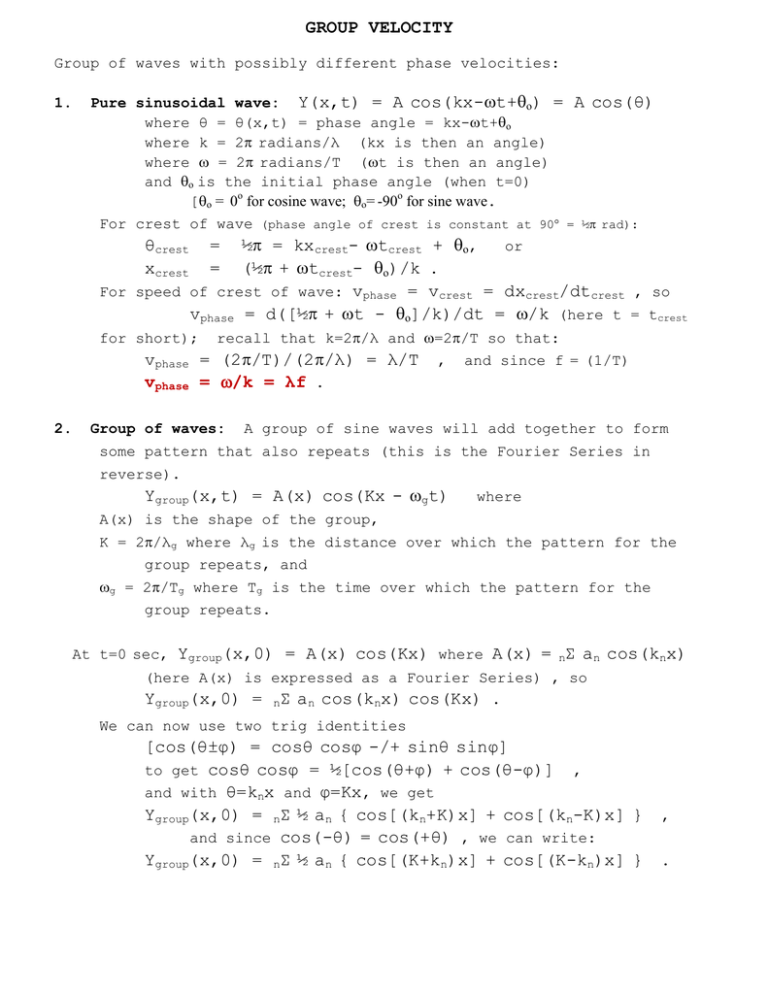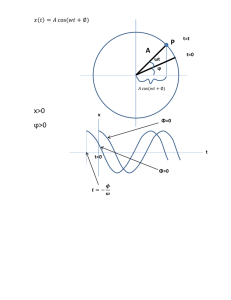GROUP VELOCITY ωt+θo) = A cos(θ) θcrest = ½π = kxcrest
advertisement

GROUP VELOCITY
Group of waves with possibly different phase velocities:
1.
Pure sinusoidal wave: Y(x,t) = A cos(kx-t+o) = A cos(θ)
where θ = θ(x,t) = phase angle = kx-t+o
where k = 2 radians/λ (kx is then an angle)
where = 2 radians/T (t is then an angle)
and o is the initial phase angle (when t=0)
[o = 0o for cosine wave; o= -90o for sine wave.
For crest of wave (phase angle of crest is constant at 90 = ½ rad):
θcrest = ½ = kxcrest- tcrest + o,
or
(½ + tcrest- o)/k .
For speed of crest of wave: vphase = vcrest = dxcrest/dtcrest , so
vphase = d([½ + t - o]/k)/dt = /k (here t = tcrest
xcrest
for short);
vphase
vphase
2.
=
recall that k=2/λ and =2/T so that:
= (2/T)/(2/λ) = λ/T , and since f = (1/T)
= /k = λf .
Group of waves:
A group of sine waves will add together to form
some pattern that also repeats (this is the Fourier Series in
reverse).
Ygroup(x,t) = A(x) cos(Kx - gt)
where
A(x) is the shape of the group,
K = 2/λg where λg is the distance over which the pattern for the
group repeats, and
g = 2/Tg where Tg is the time over which the pattern for the
group repeats.
At t=0 sec, Ygroup(x,0) = A(x) cos(Kx) where A(x) = nΣ an cos(knx)
(here A(x) is expressed as a Fourier Series) , so
Ygroup(x,0) = nΣ an cos(knx) cos(Kx) .
We can now use two trig identities
[cos(θ±φ) = cosθ cosφ -/+ sinθ sinφ]
to get cosθ cosφ = ½[cos(θ+φ) + cos(θ-φ)] ,
and with θ=knx and φ=Kx, we get
Ygroup(x,0) = nΣ ½ an { cos[(kn+K)x] + cos[(kn-K)x] }
and since cos(-θ) = cos(+θ) , we can write:
Ygroup(x,0) = nΣ ½ an { cos[(K+kn)x] + cos[(K-kn)x] }
,
.
Now put in the time dependence such that wherever we had a Kx, we put
in an additional -t:
(Kx) → (Kx-t):
Ygroup(x,t) = nΣ ½ an { cos[(K+kn)x-+t] + cos[(K-kn)x--t] }
where we use ± to indicate that depends on k=(K±kn) .
[Recall that vphase = /k, and vphase may not be constant but may depend on (vary with)
.]
Since is a function of k [(k) = vphasek], we can expand (k) in a
Taylor Series about k=K:
(K±kn) = (K) ± (d/dk)K kn + higher order terms which we neglect ;
now let's let vg (d/dk)K so that ± = (K±kn) (K) ± vgkn ,
so
Ygroup(x,t) = nΣ ½ an {cos[(K+kn)x - (+vgkn)t] + cos[(K-kn)x - (-vgkn)t] }
or re-grouping terms:
Ygroup(x,t) = nΣ ½ an { cos[(Kx-t)+kn(x-vgt)] + cos[(Kx-t)-kn(x-vgt)] } .
We can again use our trig identity:
cos(θ+φ) + cos(θ-φ) = 2 cosθ cosφ ,
where θ = (Kx-t) and φ = kn(x-vgt) , to get:
Ygroup = nΣ an cos(Kx-t) cos[kn(x-vgt)] ;
but here the cos(Kx-t) can come out of the summation, so
Ygroup = { nΣ an cos[kn(x-vgt)} cos(Kx-t) = A(x-vgt) cos(Kx-t),
where we identify the function A(x-vgt) as the original
Fourier series with x replaced by (x-vgt); that is, the shape
moves through space with a speed of vg, hence the name
group velocity.
3.
Review:
vphase = /k = λf
(good for any pure sine wave [or cosine wave]
of wavelength λ and frequency f
[or wavevector k and angular speed ]) ;
vgroup = d/dk .
4.
Special case:
If vphase = constant, then = vphasek , and so
vgroup = d/dk = d[vphasek]/dk = vphase .





